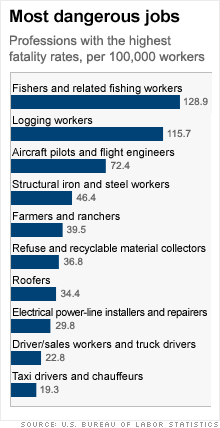
August 21, 2009
Workplace fatalities decline

 On-the-job deaths dropped 10% in 2008, government says, and the recession appears to have played a part.
On-the-job deaths dropped 10% in 2008, government says, and the recession appears to have played a part.NEW YORK (CNNMoney.com) — On-the-job fatalities dropped in 2008 in part because the recession kept millions of workers at home, according to a government report released Thursday.
Fatal work injuries totaled 5,071 in 2008, a 10% drop from 5,657 deaths the prior year.
“It’s pretty clear to us that the economy has at least some part to play in the lower numbers of fatal work injuries in 2008,” said Scott Richardson, a program manager at the Bureau of Labor Statistics. “But it’s not yet clear as to what proportion that was, or to what proportion other factors may have played a part.”
The steepest declines were in the construction industry, in which fatalities declined 20% to 969 from 1,204 in 2007. In the sub-category of residential building construction, fatalities dropped even further, by 28%, to 93 deaths.
Construction was still the deadliest industry, with 969 fatalities last year, at a rate of 9.6 per 100,000, the report said. But the highest death rate — 29.4 per 100,000 — was in agriculture, forestry, fishing and hunting, with 651 fatalities in all.
Overall, the rate per 100,000 workers declined to 3.6 from 4.
For Paul Roldan, a business agent who represents the Laborers Local 325 in Jersey City, N.J., the reason for the decline is obvious: Fewer people are on the job as the recession grinds on.
“The work has slowed down drastically and dramatically,” said Roldan. “If people aren’t working, then there’s less of a reason to get hurt.”
Some 6.7 million jobs were lost in the United States from the beginning of 2008 until July 2009. The unemployment rate in July was 9.4%.
The disparity between workplace suicides and homicides is among the most puzzling details to emerge in the report, according to Richardson, the labor agency analyst.
Workplace suicides rose 28% to 251 deaths in 2008, the biggest increase since the bureau began tracking this information in 1992. But workplace homicides dropped 18% in that same time period, the report said.
“We were surprised at the lower homicide total, simply because a lot of research has showed a lot of correlation between higher unemployment and higher homicide numbers,” said Richardson. He added that the suicide figures do not take into account work-related suicides that occur outside of the workplace.
Part of the study focused on racial demographics, showing an 8% decline in fatalities for white workers, but much greater declines for non-whites. Fatalities dropped 16% among black workers and 17% among Hispanic workers, the report said. The decline was especially dramatic among Hispanics born outside the U.S., dropping 24% to 480 deaths in 2008, compared to a 3% drop among U.S.-born Hispanics.
Richardson would not comment on the racial disparity statistics. But Roldan, the labor union business agent, theorized that layoffs hit the private sector the hardest, which tend to hire non-union members, and many of them are immigrants.
“It’s appealing to contractors to hire them more, because it’s more money for them to put in their pockets,” said Roldan.